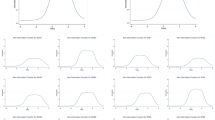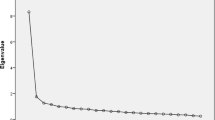Abstract
This study sought to provide information on the Social Phobia Scale (SPS) and Social Interaction Anxiety Scale (SIAS) of Mattick and Clarke (1989) with respect to factor structure, relations with psychopathology, and sex differences. A sample of 200 university students completed the SPS and SIAS and various measures of anxiety symptoms and depression. The results from the factor analyses for the sample as a whole suggest the presence of three factors corresponding to scrutiny fears, social interaction anxiety, and a general level of discomfort in social interactions. The results for men replicated this structure. For women, the three-factor solution demonstrated a blurring between the types of anxiety-provoking situations, and a general discomfort in situations involving differences in social power. In general, the discomfort factor was not correlated with measures of pathology, raising the possibility that uneasiness in these situations represents a process that is not part of social anxiety. The distinction between scrutiny fears and social interaction anxiety was also supported by the pattern of partial correlations that suggests that the presence of scrutiny fears is a stronger predictor of psychopathology than is social interaction anxiety, especially for men.
Similar content being viewed by others
References
American Psychiatric Association (1994).Diagnostic and statistical manual of mental disorders. Washington, DC: American Psychiatric Association.
Amies, P. L., Gelder, M. G., & Shaw, P. M. (1983). Social phobia: A comparative clinical study.British Journal of Psychiatry, 142, 174–179.
Beck, A. T., Rush, A. J., Shaw, B. F., & Emery, G. (1979).Cognitive therapy of depression. New York: Guilford Press.
Beck, A. T., Epstein, N., Brown, G., & Steer, R. A. (1988). An inventory for measuring clinical anxiety: Psychometric properties.Journal of Consulting and Clinical Psychology, 56, 893–897.
Beck, A. T., Steer, R. A., & Garbin, M. G. (1988). Psychometric properties of the Beck Depression Inventory: Twenty-five years of evaluation.Clinical Psychology Review, 8, 77–100.
Beidel, D. C., Borden, J. W., Turner, S. M., & Jacob, R. G. (1989). The Social Phobia and Anxiety Inventory: Concurrent validity with a clinical sample.Behaviour Research and Therapy, 27, 573–576.
Beidel, D. C., Turner, S. M., Stanley, M. A., & Dancu, C. V. (1989). The Social Phobia and Anxiety Inventory: Concurrent and external validity.Behavior Therapy, 20, 417–427.
Boone, M. L., Carter, L. E., Turk, C. L., Ries, B. J., Heimberg, R. G., & McNeil, D. W. (1992).Comparison of contemporary social phobia instruments using behavioral and cognitive criterion measures. Paper presented at the meeting of the Association for Advancement of Behavior Therapy, Boston, MA, Nov.
Borden, J. W., Peterson, D. R., & Jackson, E. A. (1991). The Beck Anxiety Inventory in nonclinical samples: Initial psychometric properties.Journal of Psychopathology and Behavioral Assessment, 13, 345–356.
Bourdon, K. H., Boyd, J. H., Rae, D. S., Burns, B. J., Thompson, J. W., & Locke, B. Z. (1988). Gender differences in phobias: Results of the ECA Community Survey.Journal of Anxiety Disorders, 2, 227–241.
Brown, E. J., Turovsky, J., Heimberg, R. G., Brown, T. A., & Barlow, D. H. (1994).Validation of the Social Interaction Anxiety Scale and the Social Phobia Scale across anxiety disorders, Unpublished manuscript. Albany: State University of New York at Albany.
Comrey, A. L. (1988). Factor analytic methods of scale construction in personality and clinical psychology.Journal of Consulting and Clinical Psychology, 56, 754–761.
Cox, B. J., & Swinson, R. P. (1995). Assessment and measurement of social phobia. In M. B. Stein (Ed.),Social Phobia: Clinical and Research Perspectives (pp. 261–292). Washington, DC: American Psychiatric Press.
Dixon, W. A., Heppner, P. P., Burnett, J. W., & Lips, B. J. (1993). Hopelessness and stress: Evidence for an interactive model of depression.Cognitive Therapy and Research, 17, 39–52.
Dovidio, J. F., Ellyson, S. L., Keating, C. F., Heltman, K., & Brown, C. E. (1988). Relationship of social power to visual displays of dominance between men and women.Journal of Personality and Social Psychology, 54, 233–242.
Endler, N. S., Edwards, J. M., & Vitelli, R. (1991).Endler Multidimensional Anxiety Scales (EMAS). Los Angeles: Western Psychological Services.
Feingold, A. (1994). Gender differences in personality: A meta-analysis.Psychological Bulletin, 116, 429–456.
Fydrich, T., Dowdall, D., & Chambless, D. L. (1992). Reliability and validity of the Beck Anxiety Inventory.Journal of Anxiety Disorders, 6, 55–61.
Harman, H. H. (1976).Modern factor analysis. Chicago: University of Chicago Press.
Heimberg, R. G., Mueller, G. P., Holt, C. S., Hope, D. A., & Liebowitz, M. R. (1992). Assessment of anxiety in social interaction and being observed by others: The Social Interaction Anxiety Scale and the Social Phobia Scale.Behavior Therapy, 23, 53–73.
Hewitt, P. L., & Norton, G. R. (1993). The Beck Anxiety Inventory: A psychometric analysis.Psychological Assessment, 5, 408–412.
Hodgson, R. J., & Rachman, S. (1977). Obsessional-compulsive complaints.Behaviour Research and Therapy, 18, 61–66.
Holt, C. S., Heimberg, R. G., Hope, D. A., & Liebowitz, M. R. (1992). Situational domains of social phobia.Journal of Anxiety Disorders, 6, 63–77.
Jones, W. H., Briggs, S. R., & Smith, T. G. (1986). Shyness: Conceptualization and measurement.Journal of Personality and Social Psychology, 51, 629–639.
Leary, M. R. (1983).Understanding social anxiety. Beverly Hills: Sage.
Liebowitz, M. R. (1987). Social Phobia.Modern Problems in Pharmacopsychiatry, 22, 141–173.
Mattick, R. P., & Clarke, J. C. (1989).Development and validation of measures of social phobia scrutiny fears and social interaction anxiety, Unpublished manuscript.
Norton, G. R., Cox, B. J., Hewitt, P. L., & McLeod, L. (1977). Personality factors associated with generalized and non-generalized social anxiety.Personality and Individual Differences (in press).
Osman, A., Barrios, F. X., Aukes, D., & Osman, J. R. (1995). Psychometric evaluation of the Social Phobia and Anxiety Inventory in college students.Journal of Clinical Psychology, 51, 235–243.
Paulhus, D. L., & Reid, D. B. (1991). Enhancement and denial in socially desirable responding.Journal of Personality and Social Psychology, 60, 307–317.
Rachman, S. J., & Hodgson, R. J. (1980).Obsessions and compulsions. Englewood Cliffs, NJ: Prentice-Hall.
Schneier, F. R., Johnson, J., Hornig, C. D., Liebowitz, M. R., & Weissman, M. M. (1992). Social phobia: Comorbidity and morbidity in an epidemiologic sample.Archives of General Psychiatry, 49, 282–288.
Stein, M. B., Walker, J. R., & Forde, D. R. (1994). Setting diagnostic thresholds for social phobia: Considerations from a community survey of social phobia.American Journal of Psychiatry, 151, 408–412.
Turner, S. M., Beidel, D. C., Dancu, C. V., & Keys, D. J. (1986). Psychopathology of social phobia and comparison to avoidant personality disorder.Journal of Abnormal Psychology, 95, 389–394.
Turner, S. M., Beidel, D. C., Dancu, C. V., & Stanley, M. A. (1989). An empirically-derived inventory to measure social fears and anxiety: The Social Phobia and Anxiety Inventory.Psychological Assessment, 1, 35–40.
Turner, S. M., Stanley, M. A., Beidel, D. C., & Bond, L. (1989). The Social Phobia and Anxiety Inventory: Construct validity.Journal of Psychopathology and Behavioral Assessment, 11, 221–234.
Turner, S. M., Beidel, D. C., & Townsley, R. M. (1992). Social phobia: A comparison of specific and generalized subtypes and avoidant personality disorder.Journal of Abnormal Psychology, 101, 326–331.
Watson, D., & Friend, R., (1969). Measurement of social-evaluative anxiety.Journal of Consulting and Clinical Psychology, 33, 448–457.
Author information
Authors and Affiliations
Rights and permissions
About this article
Cite this article
Habke, A.M., Hewitt, P.L., Norton, G.R. et al. The social phobia and social interaction anxiety scales: An exploration of the dimensions of social anxiety and sex differences in structure and relations with pathology. J Psychopathol Behav Assess 19, 21–39 (1997). https://doi.org/10.1007/BF02263227
Accepted:
Issue Date:
DOI: https://doi.org/10.1007/BF02263227




